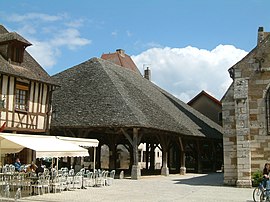Nolay, Côte-d'Or
Nolay | |
|---|---|
 Old market | |
| Country | France |
| Region | Bourgogne-Franche-Comté |
| Department | Côte-d'Or |
| Arrondissement | Beaune |
| Canton | Nolay |
| Intercommunality | Beaune Côte et Sud |
| Government | |
| • Mayor (2008–2014) | Jean-Pascal Monin |
| Area 1 | 14.3 km2 (5.5 sq mi) |
| Population (2008) | 1,496 |
| • Density | 100/km2 (270/sq mi) |
| Time zone | UTC+01:00 (CET) |
| • Summer (DST) | UTC+02:00 (CEST) |
| INSEE/Postal code | 21461 /21340 |
| Elevation | 297–542 m (974–1,778 ft) (avg. 342 m or 1,122 ft) |
| 1 French Land Register data, which excludes lakes, ponds, glaciers > 1 km2 (0.386 sq mi or 247 acres) and river estuaries. | |
Nolay is a commune in the Côte-d'Or department in eastern France. The 18th-century French physician and encyclopédiste Louis-Anne La Virotte (1725–1759) was born in Nolay.
Geography
Nolay is located in the heart of the Cozanne Valley. The town marks the transition between the forests and plains to the north and west and the hillside vineyards of the wealthy Burgundian wine regions surrounding Beaune and the Chalonnaise hills to the south.
Population
| Year | Pop. | ±% |
|---|---|---|
| 1962 | 1,587 | — |
| 1968 | 1,589 | +0.1% |
| 1975 | 1,647 | +3.7% |
| 1982 | 1,582 | −3.9% |
| 1990 | 1,551 | −2.0% |
| 1999 | 1,547 | −0.3% |
| 2008 | 1,496 | −3.3% |
Sights
Nolay is a small medieval market town, widely regarded as one of the most beautiful towns on the southern edge of the Côte-d'Or with its 14th century Central Market and wooden framed houses.
Lazare Carnot's birth house is a local attraction.
Transportation
The D973 runs through the town from La Rochepot and Beaune to the east and Saisy and Autun to the west.
See also
References
-
Central Market
-
Central Market
-
Overview
-
Saint Martin's church
-
Bourgogne wine
-
Lazare Carnot
-
Statue of Carnot in Nolay
-
Timber framed house
-
Le Bout du Monde











